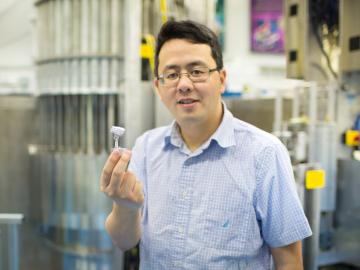
Filter News
Area of Research
- (-) Biology and Environment (180)
- (-) Neutron Science (212)
- (-) Reactor Technology (1)
- (-) Supercomputing (319)
- Advanced Manufacturing (34)
- Biological Systems (18)
- Biology and Soft Matter (5)
- Building Technologies (12)
- Chemical and Engineering Materials (4)
- Chemistry and Physics at Interfaces (11)
- Computational Biology (6)
- Computational Chemistry (5)
- Computational Engineering (5)
- Computer Science (19)
- Data (1)
- Electricity and Smart Grid (3)
- Energy Frontier Research Centers (14)
- Energy Science (526)
- Energy Sciences (5)
- Fossil Energy (3)
- Fuel Cycle Science and Technology (3)
- Functional Materials for Energy (16)
- Fusion and Fission (55)
- Fusion Energy (19)
- Geographic Information Science and Technology (3)
- Isotope Development and Production (3)
- Isotopes (36)
- Materials (433)
- Materials Characterization (2)
- Materials for Computing (36)
- Materials Synthesis from Atoms to Systems (13)
- Materials Under Extremes (12)
- Mathematics (1)
- National Security (80)
- Neutron Data Analysis and Visualization (4)
- Nuclear Science and Technology (75)
- Nuclear Systems Modeling, Simulation and Validation (3)
- Nuclear Systems Technology (1)
- Quantum Condensed Matter (4)
- Quantum information Science (9)
- Sensors and Controls (5)
- Transportation Systems (11)
News Type
News Topics
- 3-D Printing/Advanced Manufacturing (17)
- Advanced Reactors (3)
- Artificial Intelligence (44)
- Big Data (30)
- Bioenergy (54)
- Biology (79)
- Biomedical (39)
- Biotechnology (15)
- Buildings (6)
- Chemical Sciences (17)
- Clean Water (13)
- Composites (5)
- Computer Science (108)
- Coronavirus (26)
- Critical Materials (4)
- Cybersecurity (9)
- Energy Storage (17)
- Environment (112)
- Exascale Computing (28)
- Fossil Energy (1)
- Frontier (33)
- Fusion (2)
- Grid (7)
- High-Performance Computing (57)
- Hydropower (9)
- Isotopes (3)
- Machine Learning (22)
- Materials (36)
- Materials Science (38)
- Mathematics (5)
- Mercury (7)
- Microscopy (17)
- Molten Salt (1)
- Nanotechnology (24)
- National Security (9)
- Neutron Science (122)
- Nuclear Energy (8)
- Partnerships (6)
- Physics (18)
- Polymers (5)
- Quantum Computing (20)
- Quantum Science (30)
- Security (7)
- Simulation (26)
- Software (1)
- Space Exploration (5)
- Summit (47)
- Transportation (12)
Media Contacts




A new integrated computational model reduces uncertainty in climate predictions by bridging Earth systems with energy and economic models and large-scale human impact data. Co-developed by Oak Ridge National Laboratory, the novel integrated Earth system model, or iESM, leverages the power of supercomputers, including ORNL’s Titan, to couple biospheric feedbacks from oceans, atmosphere and land with human activity, such as fossil fuel emissions, agriculture and land use.

Oak Ridge National Laboratory today welcomed the first cohort of innovators to join Innovation Crossroads, the Southeast region's first entrepreneurial research and development program based at a U.S. Department of Energy national laboratory. Innovation Crossroads, ...

Virginia-based Lenvio Inc. has exclusively licensed a cyber security technology from the Department of Energy’s Oak Ridge National Laboratory that can quickly detect malicious behavior in software not previously identified as a threat.

In a first for deep learning, an Oak Ridge National Laboratory-led team is bringing together quantum, high-performance and neuromorphic computing architectures to address complex issues that, if resolved, could clear the way for more flexible, efficient technologies in intelligent computing.


Ecologist Virginia Dale is an ORNL corporate fellow and director of the lab’s Center for BioEnergy Sustainability. In her work she focuses on environmental decision making, plant succession, land-use change, landscape ecology, ecological modeling, sustainability, and bioenergy systems. Dale...



